What's inside the cable headend
 Bashny.Net
Bashny.Net
Habré have post about headend IPTV. It was to tell you about ways to receive and further transmission of the signal from the satellites on IP-networks. I'll write about that part of the headend is cable i> television and how it all works. Beware, lots of pictures and text.

General scheme
As I wrote in the beginning, unlike IPTV headend CATV should be in every place where it is planned abundance subscribers. The reason is simple - the signal comes in CATV subscriber has a completely different environment - coaxial cable, it is not able to convey through an IP network. At the same time broadcasting taken from satellites, you can safely pass from the main headend (IGU) to regional (CSG) as Multicast'a through IP-based network. Below is an example with concept.

Of course, the big operators can be several IGU to reserve and making channels with different geographically remote satellites.
Somewhere we must take local ethereal channels. You need to show the local weather, advertising, news. To this there are two options - either take their normal terrestrial antenna with ether, digitize, convert and transfer the caller or pick up directly from the holders of content (RTPTS) Second Embodiment usually more expensive - you need to be joined by the organization, to place her my equipment . In this mostly local channels take with ether.
Some theory
People often confusion occurs, what they look at the TV. Actually now are 3 types of broadcasting
Analog - you catch it conventional antenna in the attic or the balcony, although the operator can and sell it through a cable Digital - DVB, digital signal now IPTV - classic multicast, who comes to your house via the Internet «Television via Internet" - under this usually refers youtube, Smartv, in general, what you see through the usual questions Y Each type has its advantages.
Analog television is good because it will work in any old TV without using any converters. For each channel are allocated band in 8MHz, if you look at the unit of measurement of the spectrum, you clearly see the carrier of sound and image.
In the digital TV (DVB) are used tezhe frequency as in analog. The key difference is that in the 8MHz band can be stuffed a lot of channels. You will not see a single carrier in the band, the signal will be evenly distributed along it. Furthermore, due to the fact that the signal now digital, it is possible to encrypt it. With this approach, it became possible to make packages of channels to subscribers. Nothing tricky they do not - all channels (actually not all) come to you in the form of encryption, and the card is inserted into the console, contains the key to decrypt them.
The format of DVB defines several compression logic channels in one frequency band. There are various types of DVB, eg DVB-C (cable), DVB-T (terrestrial), DVB-S (satellite). Disadvantages of DVB is the fact that the subscriber is now necessary to put additional equipment and messing with the card.
IPTV is great for users, but the ISP with him to work harder. It provides additional load on existing subscriber IP-network. It is ruled Multicast. As in DVB, you can take absolutely all the channels, but some will be encrypted. Unlike DVB, IP-network podrazumenvaet not only the channel from the provider to the subscriber, but also to reverse. This allows you to use for decryption has such a pair of login and password. Overall not bad for IPTV written here .
About the "Internet TV" talk too much about, like it's obvious to most. Conventional video content is transmitted in most cases via HTTP. Provider assumes no responsibility for its quality.
Below is an example of the image of the joint analogue and digital broadcasting (DVB-C) TV in the same frequency grid.
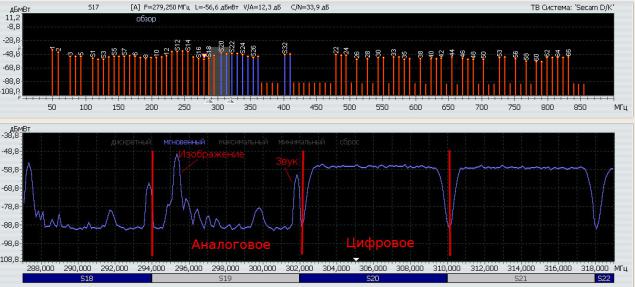
In my example in analog broadcast one channel (in my opinion, "Carousel"), and in figure 8 different channels. Clearly shows that the information in digital form is uniformly distributed across the width and analog clearly distinguished two carriers of image and sound.
The key point is the hallmark of a cable television IPTV / «over the Internet" is that the information is transmitted to only i> to the subscriber (we will not consider the same DOCSIS?), From it on your equipment will not come any answers about your experience signal error or something else. In any case, first of all have to go to him with his time-tested television and instrumentation.
Also, in contrast to IP-based networks, if you took, not the fact that it's come to the subscriber. There are no checks checksums (digital actually is, but they just lost the picture is incorrect), authentication information ...
Anticipating holivar IPTV vs KTV.
Let's just count: one channel SD-quality (480p) can be transmitted with acceptable quality with a bitrate of 3-4 MBps. HD-quality - 8-10 MBps. Total, with a channel set 180SD + 20HD operator need only spend about 1GBps (and maybe more) to uplink their equipment. It has not yet given the video recordings from different locations, multiple audio tracks. To date, conventional mass operators wired Internet uplinks between common household units 1GBps. TV stick into the current infrastructure is difficult.
On the other hand, after the construction services for the Internet remains "dark" (unused) fiber cables, fiber optic links, because they are usually placed with a margin. They can isplzovat for our purposes. In addition, there are a huge number of places are gaining momentum, technologies such as G (E) PON, which can be easily integrated cable TV.
In addition the system itself CATV less whimsical and more simple compared to IP-networks. Here you do not need to take into account Nick QoS, matching ports dubbing channels incorrect routing. This means that less attention to the brownie nodes, you can try to "put and forget" (of course when a new client may have to tighten up on brownie receiver frequency and power).
Also - normal user yet little used to the IPTV, and home TV sets compatible with this technology out of the box without prefixes also not yet appear in the huge mass.
My opinion - to the mass user IPTV today is not ready yet. As the mass operator.
What's inside
The very concept of the headend is very vague. For example, a video capture device with the AUX OUT port can be called a "headend". It will broadcast a channel not understand anything. However, we have quite a specific purpose - to organize broadcasting many channels with real content for subscribers heap. For this part of our station includes the following:
Equipment for the reception of local channels - I think that a bunch of TV tuners, they just take the ether (or whatever else) signal and converts it to IP-multicast. Antenna post - several conventional antennas for receiving terrestrial TV Decoders / modulators - convert IP-multicast in a signal that is already able to take custom TV (digital or analog) Network equipment - usually L3-Switch (yes you can and L2) for combining and mixing multicast-local and trunk channeling equipment - optical transmitter and amplifier
Now give an approximate scheme specific CSG:
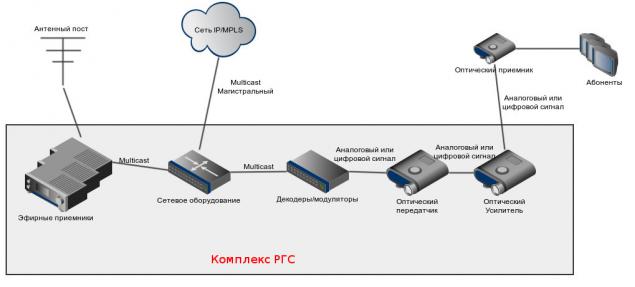
It is understood that the composition may vary depending on the situation. For example, if you have a convenient location and is easy to dock with local channels via IP-based network, you can in principle be no need antenna post.
If the image quality is poor local channels due to poor reception on the antenna post, it can be moved to another location, still leaves him with a pure multicast, which can be run through IP-based network. In several cities have so happened.
As I wrote in the theoretical part, the signal to the subscriber can go either analog or digital. Given that the digital signal operates at the same frequency grid, this is no problem.
To transfer between the optical amplifier / receiver using a laser light through the fiber at a wavelength of 1550nm. For connections using "slash" polishing APC. Something it is like DWDM.
The complex itself is not very big - a couple of racks:
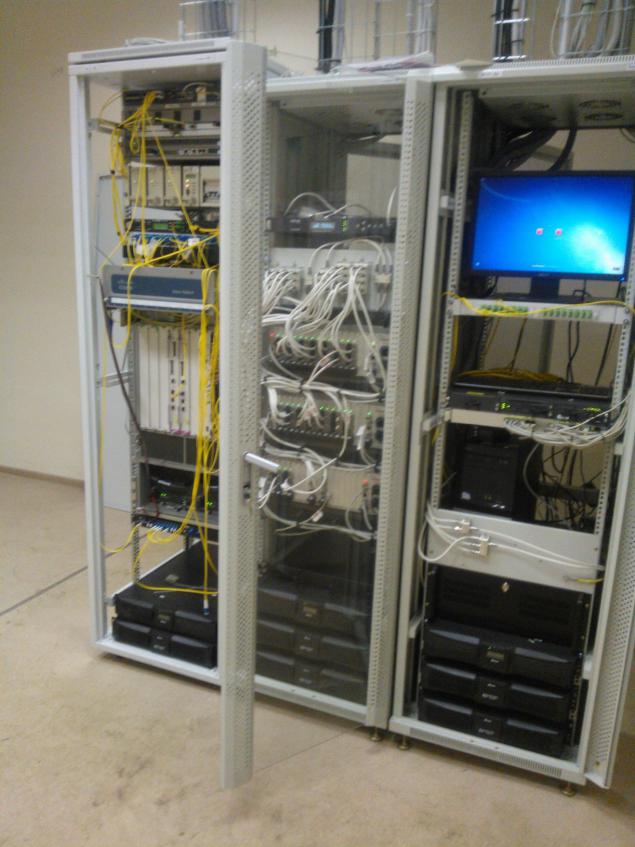
In the figure, the leftmost rack is out, there equipment is intended for the other. In addition, it is useful to add a rack monitoring equipment.
Receiving local broadcast
As stated above, it is necessary to organize the reception of local federal channels (for example, "Russia 1", "ORT"). In our case, they are taken as the analogue signal and then converted into a multicast. We use Anevia Flamingo 660 , it encoders analoka in multicast i>. By and large it sistemeny block with several set in a TV tuner. Below the image encoder back and front. Photography was not very good because the lighting is not the best.
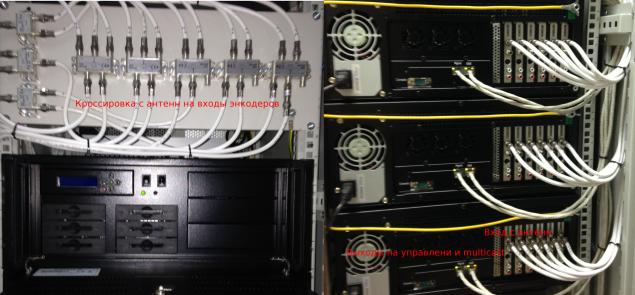
To the left is also shown strap for cross-connect outputs in antennas with inputs in the encoder. Peculiar patchpanel.
Antenna post
Signal-air channels must come from somewhere on the above description of the encoder. For this close (on the roof) of the analog encoder placed the antenna post. Since broadcasting in our country is in the meter and decimeter, put two antennas. They are connected to the encoder. Bottom photo from the roof (maybe someone know your city?)

Network equipment
So we came up with where to get content. Often took local channels, some with trunk head. On something you need to take a Multicast-traffic, routed it to filter out the excess. As I wrote before, this is a normal switch (better L3).
Here comes all the received trunk (from MGS) and local (with antenna post) multicast. In our case it Catalyst 3750 with an additional power supply. There are mixed multicast group is often given to the monitoring of the local content can be transferred to other nearby cities. For Multicast routing raised PIM SM. The switch we still zatermenirovano management of all glands of complex CSG (a lot of addresses - each card has its own address, and it can go).

If your antenna post deleted from modulators, it shall also require any switch.
Decoders / modulators
We have the right content, it is time to pass it to the cable television network. For this you need to turn it into understandable for TVs or consoles look. For this purpose the so-called signal delivery system i>.
That is the most important piece of hardware. Just convert it all in the form that can swallow a custom TVs or consoles. Specifically, we are three chassis AppearTV DC 1000 boards.
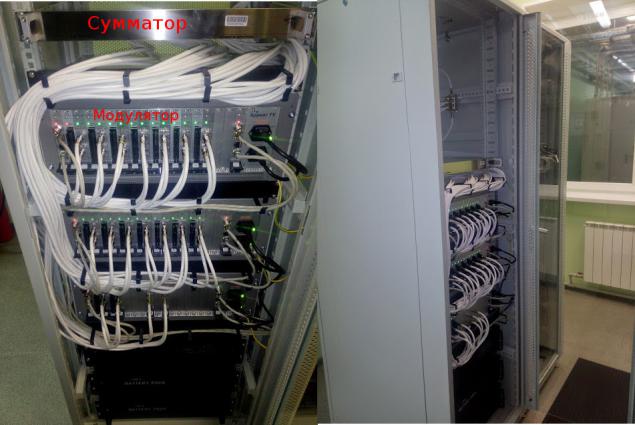
In the above case, the two upper encoded into an analog signal and the lower digitally. The analog signal is issued as follows - on each card by 2 "nipple", each of which can be given to the two channels. Total 4 channel board. With figures principle the same, only in each "channel" (frequency range) is now a pile of channels. With a lower chassis with 2 cards out as much real channels, but with the top two fully upichkanyh chassis! Bunch of wires with each port goes to the adder and goes to the optical transmitter. Unfortunately, this particular CSG I have no pictures of them, will the station from another city.
Our modular pieces of iron - a chassis (basket), which are mounted to the board for different needs. For example, for digital broadcasting can ponastavit card encryption to sell TV packages to subscribers.
The decoder takes a heap of coaxial cables in common adder, it comes already with what will happen next transmitted over the network. Here is a fashionable summer, but in general it may be just a rod with multiple electrical dividers / couplers.
Channeling equipment
Ok, we have all the necessary signal to us! Now we have to get him the misuse subscribers. Generally it has the elements of a cable network, and here it is necessary to think that you need. But in general terms as part of the CSG used for this optical transmitter and amplifier.
In the optical transmitter comes coaxial cable and optical fiber exits. Thereon at a wavelength of 1550 nm signal is transmitted. The signal is mixed - there is information in analog form, and digital.

The image is on top of the optical transmitter, the bottom - the optical amplifier. Please note - grinding on jumpers APC.
Well, after all. Here begins the elements of the cable television network - dividers, brownies optical receivers, power amplifiers, and subscribers to their nonworking TVs, soaring consoles, leads on the wire ...
Accessories
We launched the headend and our subscribers can (if the art in the field did everything right) watch telvizor! Now the fun begins - our station must serve. It is useful to put accessories.
Specifically we have is an ordinary computer with a TV tuner for remote viewing channel availability with exit CSG, VLC to view the Multicast-flow at the inlet to the CSG. While we did not come up with more intelligent than just connect via RDP and see what shows through the TV tuner. Certainly not very comfortable, but the typical problems (no image, no sound, wrong color rendering PAL / SECAM, etc.) can be solved.
Also, it is connected to the measuring device (planar) for assessing the signal strength and signal / noise ratio. Well, it goes together with the constant broadcasting pictures "channel is temporarily unavailable", which is automatically activated in the event of failure of any channel.
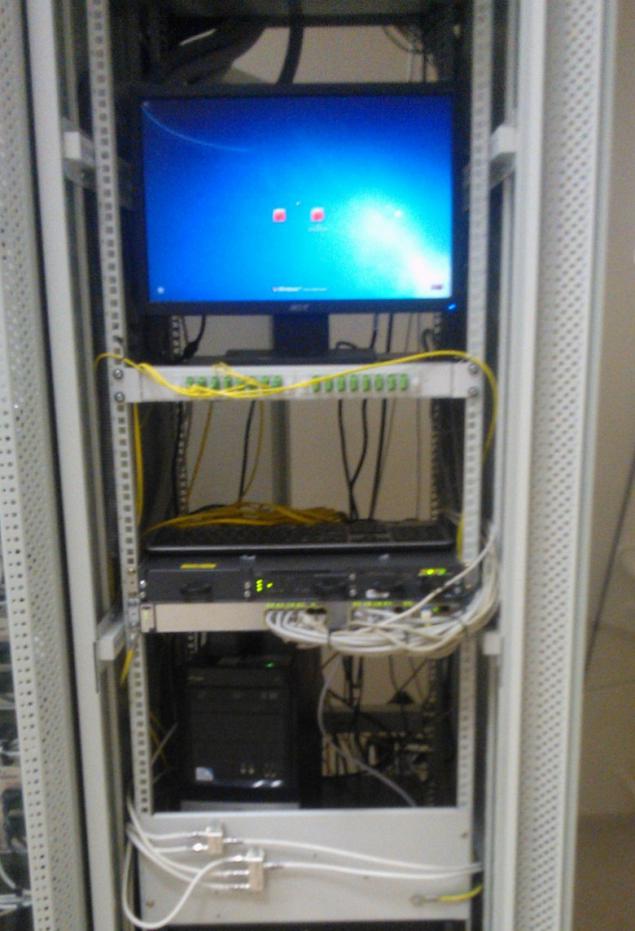
In conclusion
I showed the basic idea of what it consists of cable headend (CSG TRI) and how it works. It is important to remember the general principle of the passage of the content from the antenna to the subscriber:
antenna encoders (TV tuner) Switch Modulators Transmitters leaving some useful links:
Table 1. frequencies of TV channels in our country (OIRT)
2. Частоты air channels in Russian cities
3. good site with a detailed description of the principles of the
PS Thanks to the user ProgerXP service gliffy.com < / a>, which were drawn up schemes to this article.
Source: habrahabr.ru/post/165643/

General scheme
As I wrote in the beginning, unlike IPTV headend CATV should be in every place where it is planned abundance subscribers. The reason is simple - the signal comes in CATV subscriber has a completely different environment - coaxial cable, it is not able to convey through an IP network. At the same time broadcasting taken from satellites, you can safely pass from the main headend (IGU) to regional (CSG) as Multicast'a through IP-based network. Below is an example with concept.

Of course, the big operators can be several IGU to reserve and making channels with different geographically remote satellites.
Somewhere we must take local ethereal channels. You need to show the local weather, advertising, news. To this there are two options - either take their normal terrestrial antenna with ether, digitize, convert and transfer the caller or pick up directly from the holders of content (RTPTS) Second Embodiment usually more expensive - you need to be joined by the organization, to place her my equipment . In this mostly local channels take with ether.
Some theory
People often confusion occurs, what they look at the TV. Actually now are 3 types of broadcasting
Analog - you catch it conventional antenna in the attic or the balcony, although the operator can and sell it through a cable Digital - DVB, digital signal now IPTV - classic multicast, who comes to your house via the Internet «Television via Internet" - under this usually refers youtube, Smartv, in general, what you see through the usual questions Y Each type has its advantages.
Analog television is good because it will work in any old TV without using any converters. For each channel are allocated band in 8MHz, if you look at the unit of measurement of the spectrum, you clearly see the carrier of sound and image.
In the digital TV (DVB) are used tezhe frequency as in analog. The key difference is that in the 8MHz band can be stuffed a lot of channels. You will not see a single carrier in the band, the signal will be evenly distributed along it. Furthermore, due to the fact that the signal now digital, it is possible to encrypt it. With this approach, it became possible to make packages of channels to subscribers. Nothing tricky they do not - all channels (actually not all) come to you in the form of encryption, and the card is inserted into the console, contains the key to decrypt them.
The format of DVB defines several compression logic channels in one frequency band. There are various types of DVB, eg DVB-C (cable), DVB-T (terrestrial), DVB-S (satellite). Disadvantages of DVB is the fact that the subscriber is now necessary to put additional equipment and messing with the card.
IPTV is great for users, but the ISP with him to work harder. It provides additional load on existing subscriber IP-network. It is ruled Multicast. As in DVB, you can take absolutely all the channels, but some will be encrypted. Unlike DVB, IP-network podrazumenvaet not only the channel from the provider to the subscriber, but also to reverse. This allows you to use for decryption has such a pair of login and password. Overall not bad for IPTV written here .
About the "Internet TV" talk too much about, like it's obvious to most. Conventional video content is transmitted in most cases via HTTP. Provider assumes no responsibility for its quality.
Below is an example of the image of the joint analogue and digital broadcasting (DVB-C) TV in the same frequency grid.

In my example in analog broadcast one channel (in my opinion, "Carousel"), and in figure 8 different channels. Clearly shows that the information in digital form is uniformly distributed across the width and analog clearly distinguished two carriers of image and sound.
The key point is the hallmark of a cable television IPTV / «over the Internet" is that the information is transmitted to only i> to the subscriber (we will not consider the same DOCSIS?), From it on your equipment will not come any answers about your experience signal error or something else. In any case, first of all have to go to him with his time-tested television and instrumentation.
Also, in contrast to IP-based networks, if you took, not the fact that it's come to the subscriber. There are no checks checksums (digital actually is, but they just lost the picture is incorrect), authentication information ...
Anticipating holivar IPTV vs KTV.
Let's just count: one channel SD-quality (480p) can be transmitted with acceptable quality with a bitrate of 3-4 MBps. HD-quality - 8-10 MBps. Total, with a channel set 180SD + 20HD operator need only spend about 1GBps (and maybe more) to uplink their equipment. It has not yet given the video recordings from different locations, multiple audio tracks. To date, conventional mass operators wired Internet uplinks between common household units 1GBps. TV stick into the current infrastructure is difficult.
On the other hand, after the construction services for the Internet remains "dark" (unused) fiber cables, fiber optic links, because they are usually placed with a margin. They can isplzovat for our purposes. In addition, there are a huge number of places are gaining momentum, technologies such as G (E) PON, which can be easily integrated cable TV.
In addition the system itself CATV less whimsical and more simple compared to IP-networks. Here you do not need to take into account Nick QoS, matching ports dubbing channels incorrect routing. This means that less attention to the brownie nodes, you can try to "put and forget" (of course when a new client may have to tighten up on brownie receiver frequency and power).
Also - normal user yet little used to the IPTV, and home TV sets compatible with this technology out of the box without prefixes also not yet appear in the huge mass.
My opinion - to the mass user IPTV today is not ready yet. As the mass operator.
What's inside
The very concept of the headend is very vague. For example, a video capture device with the AUX OUT port can be called a "headend". It will broadcast a channel not understand anything. However, we have quite a specific purpose - to organize broadcasting many channels with real content for subscribers heap. For this part of our station includes the following:
Equipment for the reception of local channels - I think that a bunch of TV tuners, they just take the ether (or whatever else) signal and converts it to IP-multicast. Antenna post - several conventional antennas for receiving terrestrial TV Decoders / modulators - convert IP-multicast in a signal that is already able to take custom TV (digital or analog) Network equipment - usually L3-Switch (yes you can and L2) for combining and mixing multicast-local and trunk channeling equipment - optical transmitter and amplifier
Now give an approximate scheme specific CSG:

It is understood that the composition may vary depending on the situation. For example, if you have a convenient location and is easy to dock with local channels via IP-based network, you can in principle be no need antenna post.
If the image quality is poor local channels due to poor reception on the antenna post, it can be moved to another location, still leaves him with a pure multicast, which can be run through IP-based network. In several cities have so happened.
As I wrote in the theoretical part, the signal to the subscriber can go either analog or digital. Given that the digital signal operates at the same frequency grid, this is no problem.
To transfer between the optical amplifier / receiver using a laser light through the fiber at a wavelength of 1550nm. For connections using "slash" polishing APC. Something it is like DWDM.
The complex itself is not very big - a couple of racks:

In the figure, the leftmost rack is out, there equipment is intended for the other. In addition, it is useful to add a rack monitoring equipment.
Receiving local broadcast
As stated above, it is necessary to organize the reception of local federal channels (for example, "Russia 1", "ORT"). In our case, they are taken as the analogue signal and then converted into a multicast. We use Anevia Flamingo 660 , it encoders analoka in multicast i>. By and large it sistemeny block with several set in a TV tuner. Below the image encoder back and front. Photography was not very good because the lighting is not the best.

To the left is also shown strap for cross-connect outputs in antennas with inputs in the encoder. Peculiar patchpanel.
Antenna post
Signal-air channels must come from somewhere on the above description of the encoder. For this close (on the roof) of the analog encoder placed the antenna post. Since broadcasting in our country is in the meter and decimeter, put two antennas. They are connected to the encoder. Bottom photo from the roof (maybe someone know your city?)

Network equipment
So we came up with where to get content. Often took local channels, some with trunk head. On something you need to take a Multicast-traffic, routed it to filter out the excess. As I wrote before, this is a normal switch (better L3).
Here comes all the received trunk (from MGS) and local (with antenna post) multicast. In our case it Catalyst 3750 with an additional power supply. There are mixed multicast group is often given to the monitoring of the local content can be transferred to other nearby cities. For Multicast routing raised PIM SM. The switch we still zatermenirovano management of all glands of complex CSG (a lot of addresses - each card has its own address, and it can go).

If your antenna post deleted from modulators, it shall also require any switch.
Decoders / modulators
We have the right content, it is time to pass it to the cable television network. For this you need to turn it into understandable for TVs or consoles look. For this purpose the so-called signal delivery system i>.
That is the most important piece of hardware. Just convert it all in the form that can swallow a custom TVs or consoles. Specifically, we are three chassis AppearTV DC 1000 boards.

In the above case, the two upper encoded into an analog signal and the lower digitally. The analog signal is issued as follows - on each card by 2 "nipple", each of which can be given to the two channels. Total 4 channel board. With figures principle the same, only in each "channel" (frequency range) is now a pile of channels. With a lower chassis with 2 cards out as much real channels, but with the top two fully upichkanyh chassis! Bunch of wires with each port goes to the adder and goes to the optical transmitter. Unfortunately, this particular CSG I have no pictures of them, will the station from another city.
Our modular pieces of iron - a chassis (basket), which are mounted to the board for different needs. For example, for digital broadcasting can ponastavit card encryption to sell TV packages to subscribers.
The decoder takes a heap of coaxial cables in common adder, it comes already with what will happen next transmitted over the network. Here is a fashionable summer, but in general it may be just a rod with multiple electrical dividers / couplers.
Channeling equipment
Ok, we have all the necessary signal to us! Now we have to get him the misuse subscribers. Generally it has the elements of a cable network, and here it is necessary to think that you need. But in general terms as part of the CSG used for this optical transmitter and amplifier.
In the optical transmitter comes coaxial cable and optical fiber exits. Thereon at a wavelength of 1550 nm signal is transmitted. The signal is mixed - there is information in analog form, and digital.

The image is on top of the optical transmitter, the bottom - the optical amplifier. Please note - grinding on jumpers APC.
Well, after all. Here begins the elements of the cable television network - dividers, brownies optical receivers, power amplifiers, and subscribers to their nonworking TVs, soaring consoles, leads on the wire ...
Accessories
We launched the headend and our subscribers can (if the art in the field did everything right) watch telvizor! Now the fun begins - our station must serve. It is useful to put accessories.
Specifically we have is an ordinary computer with a TV tuner for remote viewing channel availability with exit CSG, VLC to view the Multicast-flow at the inlet to the CSG. While we did not come up with more intelligent than just connect via RDP and see what shows through the TV tuner. Certainly not very comfortable, but the typical problems (no image, no sound, wrong color rendering PAL / SECAM, etc.) can be solved.
Also, it is connected to the measuring device (planar) for assessing the signal strength and signal / noise ratio. Well, it goes together with the constant broadcasting pictures "channel is temporarily unavailable", which is automatically activated in the event of failure of any channel.

In conclusion
I showed the basic idea of what it consists of cable headend (CSG TRI) and how it works. It is important to remember the general principle of the passage of the content from the antenna to the subscriber:
antenna encoders (TV tuner) Switch Modulators Transmitters leaving some useful links:
Table 1. frequencies of TV channels in our country (OIRT)
2. Частоты air channels in Russian cities
3. good site with a detailed description of the principles of the
PS Thanks to the user ProgerXP service gliffy.com < / a>, which were drawn up schemes to this article.
Source: habrahabr.ru/post/165643/
Tags
See also
Quotes Kardashian
Dawn on the career of Mikhailovsky GOK
Emergency opening of cars
Five facts about Russia from the Germans, who lived with us a year
All I think about Paris after 3 years of living here
PlasticRoad: smooth and durable roads from recycled bottles
Wisdom Owl Post
23 women's habits, which it is time to quit
5 most staggering things that science has learned to do (5 photos)
Babes in tiaras

















